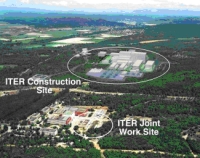Director's Corner
17 May 2007
 Barry Barish |
How to make big international science projects happen
At the annual American Physical Society meeting in Jacksonville, Florida on 14 April 2007, I participated in a special session entitled “How to make big international projects happen.” The speakers were James Van Dam, University of Texas at Austin, presenting ITER, Joe Dehmer, NSF, presenting ideas related to LHC, and me, presenting our approach for the International Linear Collider. The ILC is the baby in the group, just developing the design and without government approvals or funding for the project yet. The LHC is the furthest along, having just completed construction and beginning its commissioning programme. There is much for us to learn from the LHC and we are trying hard to take full advantage through our CERN GDE collaborators. There is also much to be learned from ITER, a different type of international project, and Van Dam’s talk was particularly interesting from that standpoint.
ITER means “the way” in Latin, which symbolises that it is the next step in developing fusion power. This ambitious step will take us from today's devices of 10 MW (for 1 second with a gain of about 1) to 500 MW (for more than 400 seconds with a gain of more than10), making it the first fusion experiment to produce net power. ITER will be the world's biggest “burning plasma” fusion energy research project. This 10-billion Euro project, scheduled to have first plasma in 2016 and operate for 20 years, is being carried out by a collaboration of seven international partners representing half the world's population.
In his talk, Van Dam cited lessons learned from ITER. I repeat them below and comment on their relevance to ILC.
“ A big international project is motivated by a big international scientific challenge”
For ITER, this challenge is to enable the practical production of fusion power. This is a common goal worldwide for governments and understood by the public. The scientific challenge for the ILC is to understand the fundamental laws of nature through studies of the Terascale. This is a much more difficult goal to sell to governments and the public, even though historically great advances in basic research have produced enormous impacts on modern society. Examples abound and range from the discovery of nuclear magnetic resonance leading to the MRI device for medical imaging to the discovery of the laser leading to CD players.
“ Strategise as a united community”
For ITER, workshops and a joint worldwide goal have followed a top-down government initiative toward an international project. The ILC is unique because the global community has agreed on the goals of developing a linear collider and has determined its parameters and basic design features.
“ Deciding on the site requires patience”
Determining the site for ITER turned out to be a big problem with a fierce final competition between France and Japan that took more than two years to resolve. We hope to determine the ILC site earlier in the process and thereby avoid such a final hang-up. The ILC design is also more intertwined with the site, since it is deep underground, making it more important to design to specific site(s).
“ Have a clear mission for the project”
For ITER, the design goals are to produce a significant fusion power amplification factor (Q ≥ 10) in long-pulse operation and to achieve steady-state operation of a tokamak (Q = 5). In the longer term they plan for the possible exploration of 'controlled ignition' (Q ≥ 30). Technically, they plan to demonstrate integrated operation of technologies and test components required for a fusion power plant, as well as test concepts for a tritium breeding module.
For the ILC, our design parameters have been set down by an international study of the Terascale precision physics goals. Technically, the accelerator and superconducting RF technology needed to achieve the high gradients and luminosity will have broad applications for future accelerators.
“ Organisation can be as much of a challenge as science”
For ITER, a complex international organisation has been developed. I will discuss some of the features and possible implications for the ILC in a future column. We are working towards plans for an international governance and central funding to be in place by the time the ILC becomes an international construction project.
“Carefully determine the cost and how to pay for it ”
We used ITER “value” costing methodology as the starting point in costing the ILC. We will determine the costs more precisely during the engineering design phase, as well as how to industrialise and divide up the project.
“ Be prepared to learn more lessons”
This final ITER “lesson” is a reminder that we can expect to find surprises at every step. We must both anticipate solutions for anticipated issues like those above, as well as be prepared to react to the inevitable surprises.
-- Barry Barish

